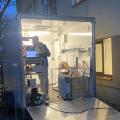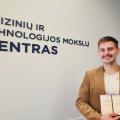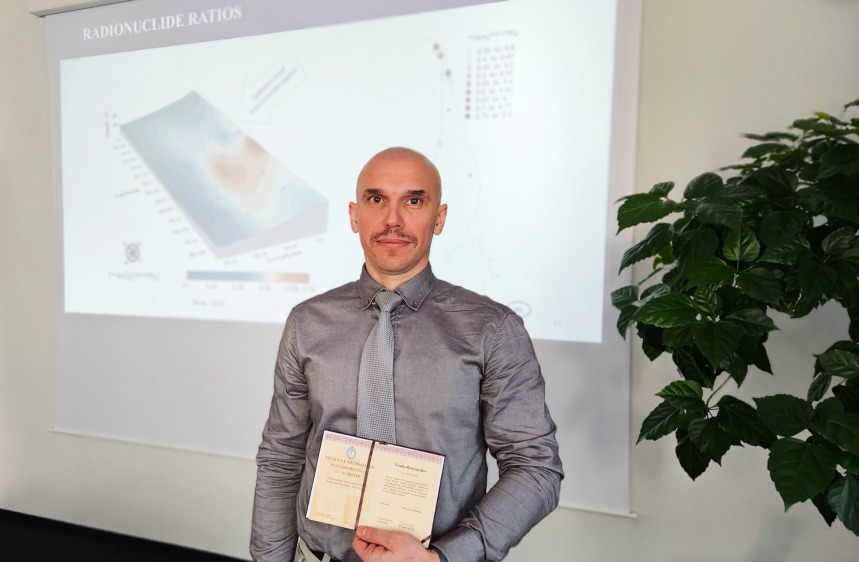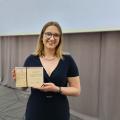Naujienos ir renginiai
- Titulinis
- Naujienos ir renginiai
- Naujienos
Naujienos
2023. 09. 29
-
FTMC physicist who studied the radioactive pollution of the Baltic Sea and The Curionian Lagoon defends his PhD thesis
Vitaliy Romanenko, a physicist from the Department of Evironmental Studies at FTMC, has defended his dissertation entitled "The Study of Anthropogenic Radionuclide Transport with Suspended Matter in the System Neman River-Baltic Sea" (academic supervisor: Dr. Galina Lujanienė).
Congratulations to the young researcher, good luck to continue significant work!
Radionuclide is an element with unstable core which release high-energy ionizing radiation. In nature, these elements can be found both natural and human made (anthropogenic).
According to the Thesis, in recent decades, the pollution of European seas, including the Baltic Sea, with radionuclides has become a significant problem. Pollution by radionuclides in this area results from direct fallout from atmospheric nuclear weapons testing and the Chernobyl accident, as well as from the delayed transport of radionuclides from these sources via rivers from contaminated basins.
More than 250 rivers flow into the Baltic Sea, providing not only fresh water but also pollutants that can have negative impacts on the environment and human health. So knowledge of potential ecological risks associated with pollutants transported by suspended matter and bottom sediments is essential for comprehensive understanding of changes in the ecological status of the Baltic Sea.

Photo: Unsplash.com
"In the past, radionuclides were considered environmental contaminants, and it was imperative to prevent their levels from exceeding thresholds hazardous to humans. Today, both pre-existing radionuclides resulting from nuclear accidents and the nuclear testing era, as well as natural radionuclides, are extensively employed as tracers in processes related to sediment transport within river systems, seas, and oceans," Vitaliy says.
He adds that radionuclides play an important role in assessing various parameters, including sediment residence time in water bodies, sediment transit time, the balance of sediments and radionuclides in aquatic environments, etc. And they also facilitate the study of pollutant transport associated with suspended particles at various scales.
Therefore, the main aim of the Thesis was the study of the transport and distribution of particle-reactive radionuclides in the suspended and bottom sediments of the Neman River, the Curonian Lagoon and the Baltic Sea in order to use them as environmental tracers. Why was this area chosen?
„The Curonian Lagoon has conditions favorable for environmental risks, including shallow depth and semi-enclosed system with limited water exchange. The ecological condition is affected by the pollutant load from the Neman River. During the era of nuclear tests and the Chernobyl incident, various man-made radionuclides, such as plutonium and cesium isotopes, were deposited onto the surface of the Baltic Sea, which also encompasses the drainage area of the Neman River. The significant difference in size between the river catchment area and the lagoon territory (about 60 times) leads to the concentration of transported nutrients, contaminants, and radionuclides.
There was a lack of information regarding the activities of fallout radionuclides, the features of their transport, and their distribution in the bottom sediments of the Curonian Lagoon and the coastal region in the southeastern part of the Baltic Sea, in order to use them as environmental tracers,“ explains Romanenko.
In simple terms, the study has shown that during the transport of radionuclides from the catchment area, their concentration increases more than ten times but still there is no real threat to nature and human health. However, scientist says, the uneven distribution of long-lived radionuclides, such as plutonium-239 and plutonium-240, in the bottom sediments can potentially lead to accumulation in significant levels for biota.

Photo: FTMC
"In the course of our work we estimated the amount of plutonium and cesium coming from the catchment area of the Neman River into the Curonian Lagoon. The results obtained indicate that the main activity of radionuclides is transported by suspended particles of coarse fraction. Spatial distribution of radionuclides in the bottom sediments of the Curonian Lagoon indicates their accumulation in certain zones with activity more than ten times higher than average values, but still far from dangerous levels.
The distribution of americium and plutonium has been used to assess the likely sources of sediments and sedimentation rates in the areas adjacent to the Curonian Lagoon. The use of plutonium isotopes allowed us to date the sediments and estimate the contribution of their sources. Thus, in this work we studied the distribution features of radionuclides in bottom sediments and used them as environmental tracers," the new PhD says.
He hopes that the results of the study may provide valuable information for the future application of particle-reactive radionuclides in studies related to the peculiarities of pollutant transport with suspended sediments in the Neman River and the subsequent fate of these pollutants in the Curonian Lagoon and the Lithuanian economic zone of the Baltic Sea.
FTMC information
Susiję:

2023. 10. 27
-
UK and FTMC researches discussed sustainability and science
Environmental research is an area where FTMC and the visiting British universities can find common ground.

2023. 10. 26
-
FTMC Mobile laboratory to study air pollution in a school
FTMC scientists will monitor the amount of microplastics and other polluting particles around children and teachers every day.

2023. 09. 22
-
Chemist R. Novikau defends his PhD on trapping of hazardous materials released into the environment
Caesium, cobalt and europium can sometimes be harmful. However, new measures are being developed to prevent this.

